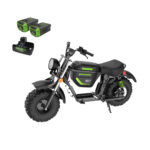Knee injuries are a serious concern for motocross and dirt bike riders. The knee joint, while designed for bending, is subjected to extreme stresses and unnatural movements in off-road riding, leading to potential sprains, tears, and long-term damage. While the debate on whether knee braces are universally effective continues, the prevalence of their use among professional riders speaks volumes. If you’re considering joining the ranks of riders who prioritize knee protection, understanding your options is crucial. Dirt Bike Knee Braces are a significant investment, not a disposable accessory. This comprehensive review dives deep into a range of top-tier dirt bike knee braces, evaluating their fit, comfort, protection, and overall performance to help you make an informed decision.
Understanding Knee Brace Fit
Finding the right fit for knee braces is paramount, and it’s more complex than simply choosing a size based on height and weight. Individual leg shapes and muscle distribution vary significantly. The testers for this review, including experienced riders with well-developed leg muscles from cycling and motocross, represent a broad spectrum of rider physiques. One tester’s weight fluctuation during the testing period highlighted the importance of adjustability, as an XL brace initially fit well but became too large after weight loss. This review primarily focuses on the XL size, with additional insights from a tester using size Large for comparative perspectives.
All knee braces in this test offer some degree of adjustability. Using different thicknesses of knee pads and adjustable straps, riders can fine-tune the fit. For testing purposes, with no pre-existing knee injuries, the extension stops on each brace were set to a mid-range setting, allowing for a balance of support and natural movement.
Dirt Bike Knee Brace Testing Methodology
The core of this review is based on real-world riding experience. Testers evaluated the knee braces in typical motocross riding conditions, focusing on comfort, mobility, and bike feel. Beyond basic measurements like weight and hinge thickness, the performance assessment was primarily subjective, based on extensive track time. One dedicated tester even pushed the limits by riding with different brace brands on each leg simultaneously to discern subtle differences in feel and performance.
Interestingly, inquiries to brace manufacturers revealed the absence of a standardized “brace dyno” or device for empirically measuring brace strength. The diverse designs and construction methods of knee braces make a single, universally applicable metric elusive. Therefore, this review emphasizes practical, on-track testing to provide relevant and insightful feedback for riders.
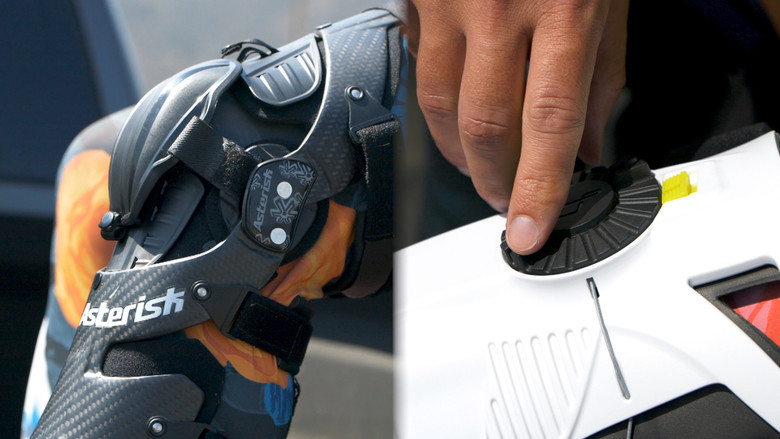 Rider wearing dirt bike knee braces in action, showcasing knee protection during a jump.
Rider wearing dirt bike knee braces in action, showcasing knee protection during a jump.
Dirt Bike Knee Brace Review Results: A Detailed Comparison
Initially, the goal was to rank the knee braces definitively from best to worst. However, testing revealed a more nuanced reality. Performance and preference are subjective and depend heavily on individual rider needs. Therefore, the braces are presented in order of price, from most expensive to least, with tester’s top picks and less favored options highlighted, rather than a rigid ranking system.
| BRACE | CTi OTS | Asterisk Carbon Cell | POD K8 | EVS Axis Pro | Mobius X8 | Leatt X Frame |
|---|---|---|---|---|---|---|
| PRICE | $799.99-$849.99 | $799.95 | $799.95 | $749 | $599.95 | $469.99 |
| HINGE | Asymmetric pivot | Asymmetric pivot | Synthetic ligament | Asymmetric pivot | Pivot | Pivot |
| FRAME MATERIAL | Carbon fiber | Carbon fiber | Carbon fiber/plastic cuffs | Aluminum/carbon cuffs | Glass-filled nylon | Carbon composite |
| STRAPS | Four, velcro, no memory | Four, velcro, no memory | Four, velcro, two w/ memory | Five, velcro, no memory | Three velcro, one ratcheting steel cable, no memory | Four, velcro, no memory |
| PATELLA CUP | Independent floating | Independent floating, w/ two piece sliding fixed | Two piece, sliding fixed | Two piece, sliding fixed | Inner floating | Fixed floating, w/ two piece sliding fixed |
| WEIGHT | 3.95 lb (1792 g) | 3.42 lb (1554 g) | 3.1 lb (1410) | 4.36 (1980 g) | 3.65 lb (1656 g) | 3.45 lb (1568 g) |
| MEDICAL | Reimbursement codes available | N/A | Certified Medical Device/FDA Registered | CE 1621-1EN 1621-1 | N/A | Certified Medical Device/FDA Registered |
CTi OTS Knee Brace Review
PRICE: $799.99 – $849.99
HINGE THICKNESS: 16.5 mm
WEIGHT: 3.95 lb pair, size Large
FRAME PROFILE THICKNESS 1-10: 3 (Moderately thin)
STRAP STYLE: 4 individual straps
STRAP MEMORY: No
CUFF CLOSURE: Flexible
HINGE STYLE: Pivoting “ACCUTRAC” Hinge
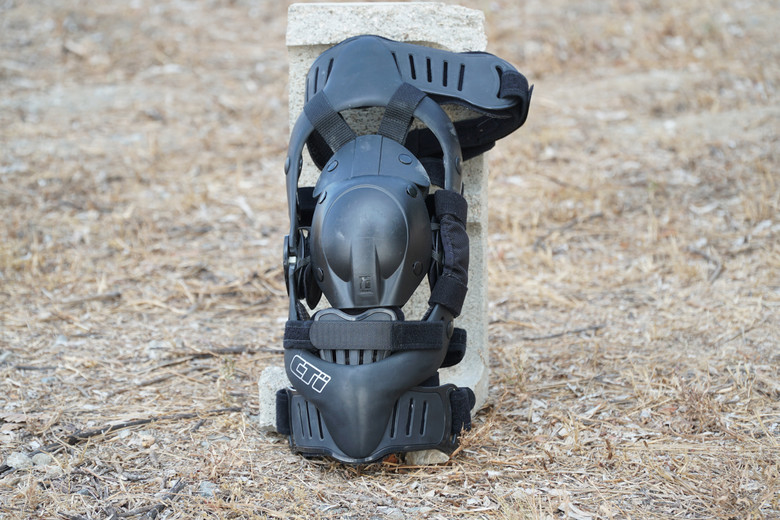 Close-up of CTi OTS knee brace hinge and carbon fiber frame.
Close-up of CTi OTS knee brace hinge and carbon fiber frame.
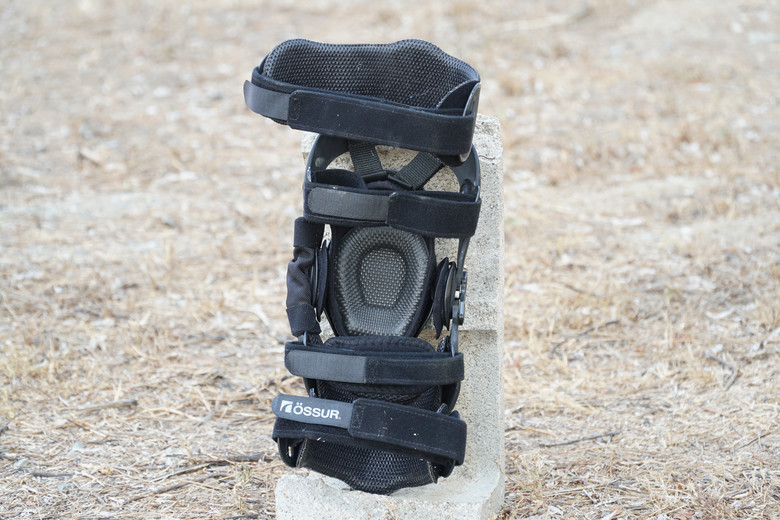 CTi OTS knee brace straps and padding details.
CTi OTS knee brace straps and padding details.
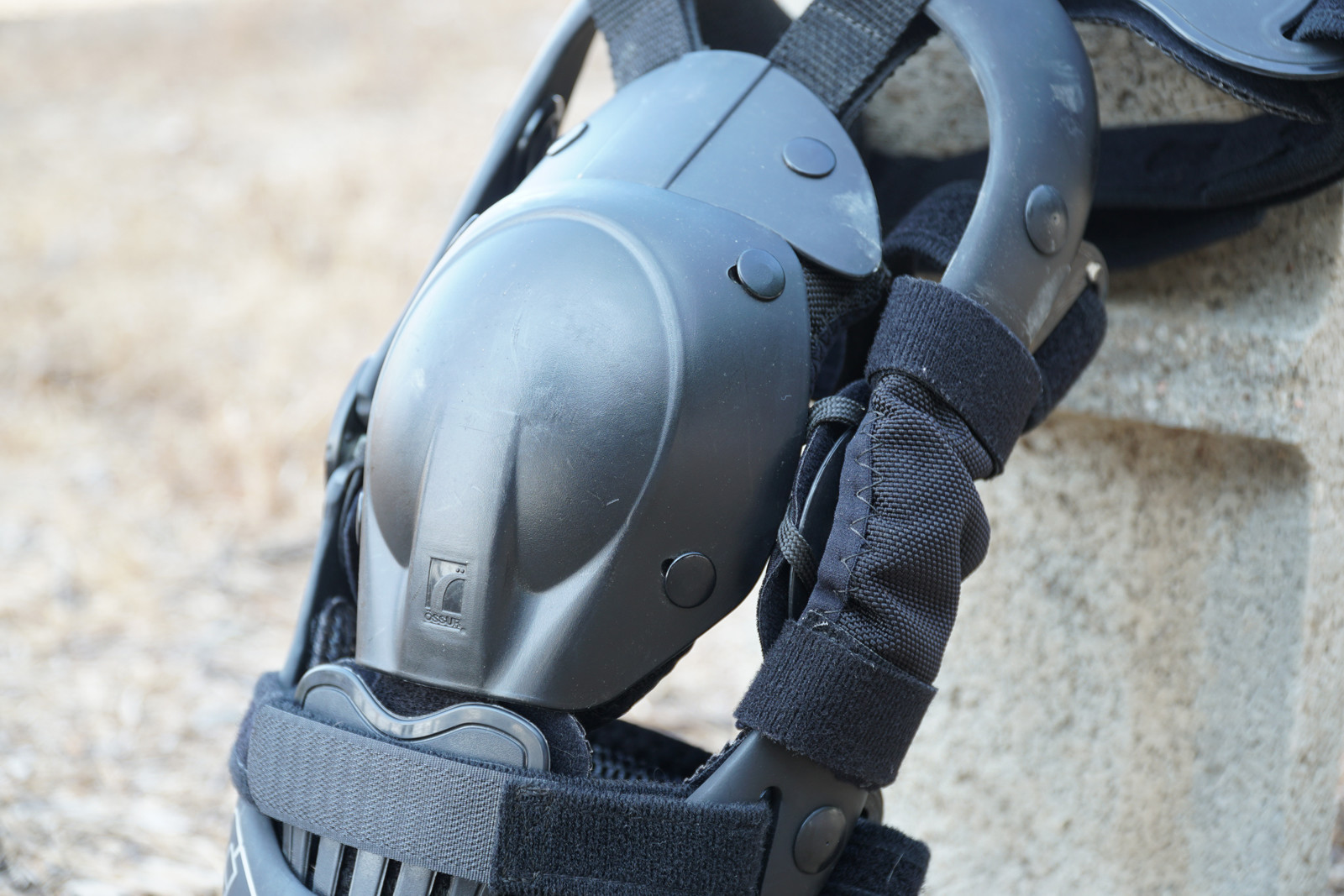 Rider wearing CTi OTS knee brace, showcasing fit under riding gear.
Rider wearing CTi OTS knee brace, showcasing fit under riding gear.
CTi, a pioneer in the motocross knee brace market, offers the OTS (Off The Shelf) knee brace, bringing their high-end technology to a more accessible price point within the premium brace category.
Tester Notes:
What We Liked:
The CTi OTS immediately stood out for its exceptional comfort. The thin, flexible thigh and calf straps effectively mold the brace to various leg shapes and sizes. The low-profile cuffs also made it less noticeable under riding pants compared to bulkier options. During riding, the contact pressure against the bike felt evenly distributed across the frame, from thigh to calf, providing secure grip without creating pressure hotspots, even during extended riding sessions.
The patented ACCUTRAC hinge is a key feature, designed to mimic the natural biomechanics of the knee joint. It allows the lower frame to rotate and slide in conjunction with the upper frame, mirroring the tibia’s movement under the femur during knee flexion. This innovative hinge design translates to a very natural, unrestricted feel on the bike.
Despite having the thickest hinge measurement in the test, it didn’t feel cumbersome. In fact, the testers noted that the wider hinge provided a solid contact point for gripping the bike. While noticeable in a side-by-side comparison with the thinnest hinge brace (Leatt X-Frame), the CTi’s hinge width was generally perceived as beneficial for bike control. The patella cup padding was also highly praised for its comfortable and protective feel, reminiscent of robust skate knee pads, offering confidence for impacts and comfortable kneeling.
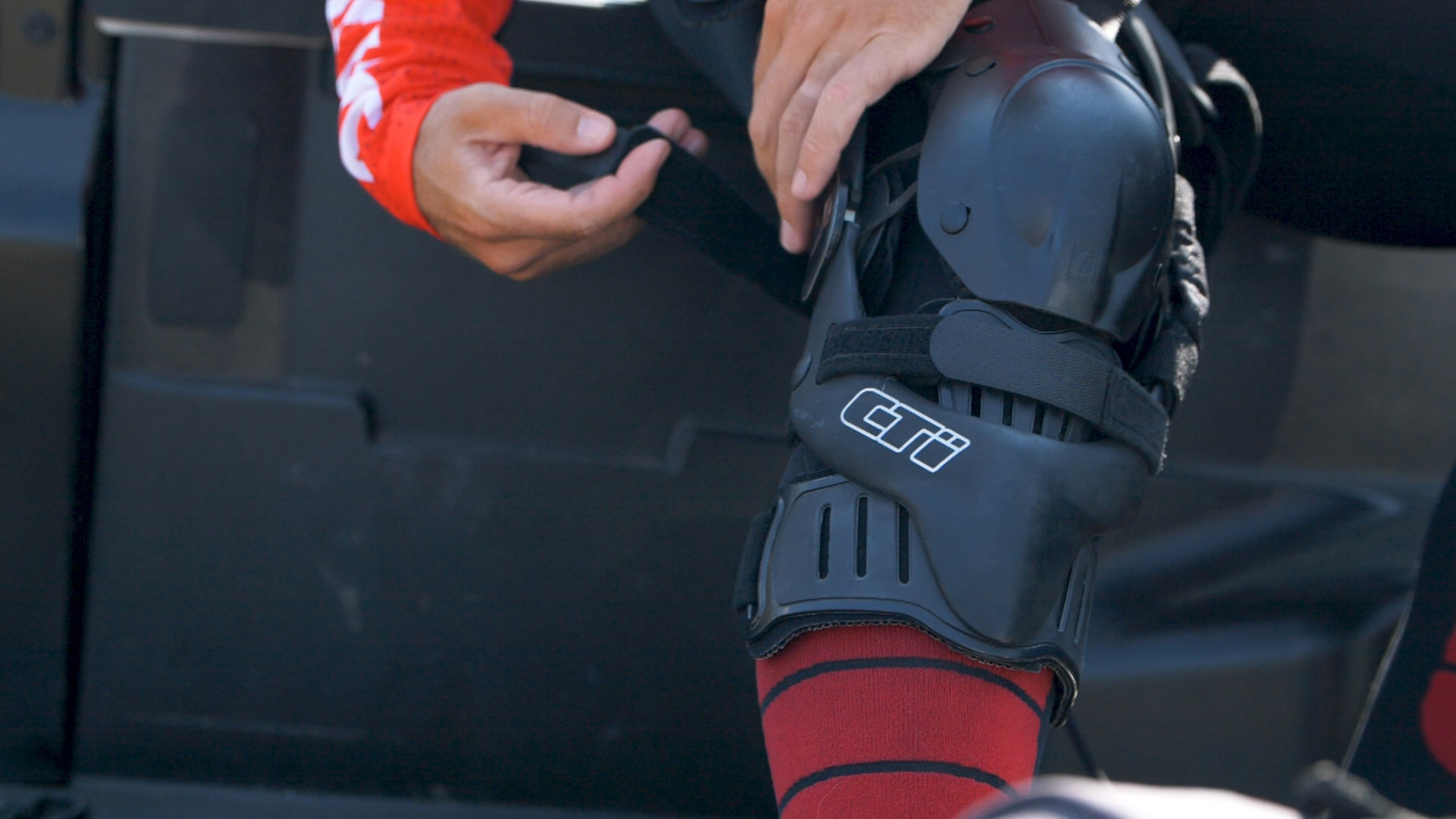 CTi ACCUTRAC hinge mechanism in motion, illustrating natural knee movement replication.
CTi ACCUTRAC hinge mechanism in motion, illustrating natural knee movement replication.
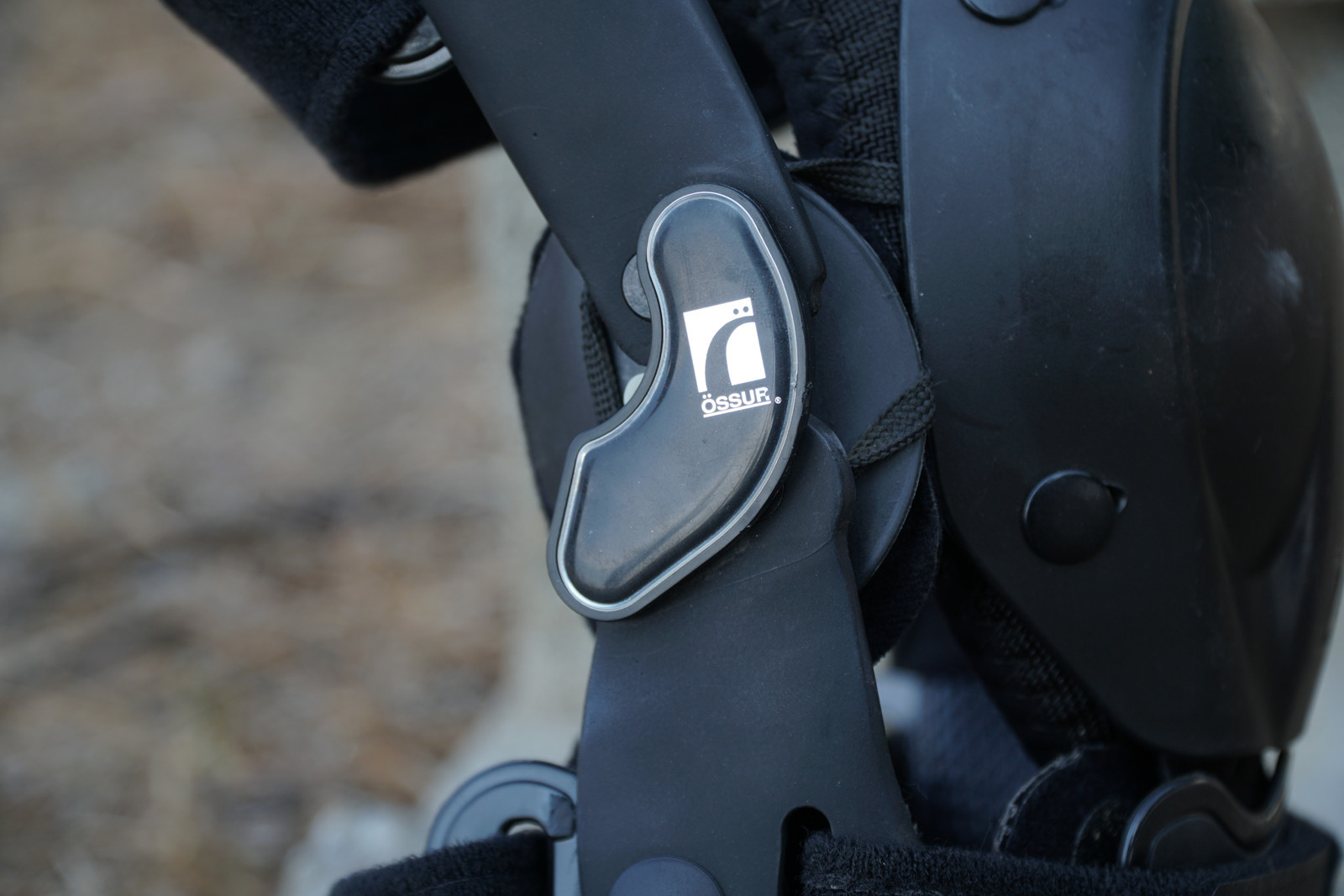 CTi OTS knee brace patella cup and padding detail, highlighting comfort and protection features.
CTi OTS knee brace patella cup and padding detail, highlighting comfort and protection features.
 Close-up of CTi OTS patella cup padding, emphasizing the material and construction.
Close-up of CTi OTS patella cup padding, emphasizing the material and construction.
What We Didn’t Like:
A potential drawback is the pointed design of the frame at both the top and bottom cuffs. Slight misadjustments of the brace stops could create pressure points on the shin, as the concentrated frame design exaggerates pressure rather than distributing it across a broader cuff. Another minor concern is a gap above the patella cup, leaving a small area potentially vulnerable to handlebar impacts in deep ruts.
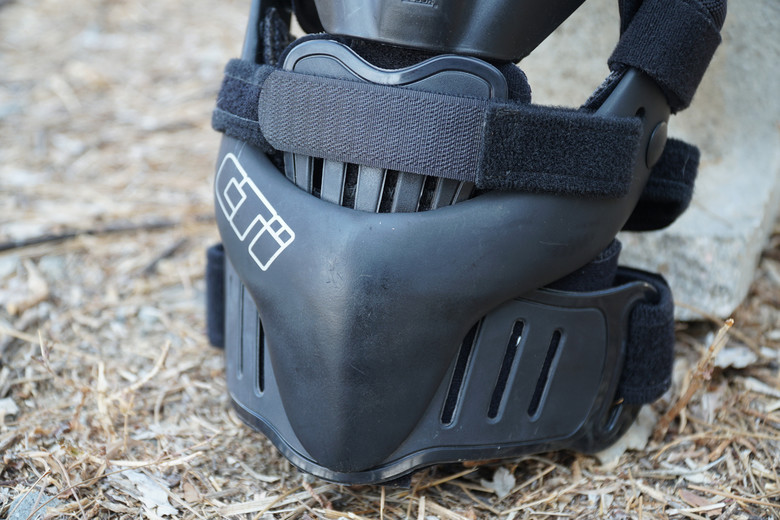 CTi OTS knee brace lower frame point, illustrating potential pressure point area on the shin.
CTi OTS knee brace lower frame point, illustrating potential pressure point area on the shin.
 CTi OTS knee brace padding material close-up, showcasing the sticky silicon material for anti-slip performance.
CTi OTS knee brace padding material close-up, showcasing the sticky silicon material for anti-slip performance.
Overall Impression:
The CTi OTS is a top contender, particularly for riders prioritizing comfort and a natural feel on the bike. While minor pressure point issues when walking and a small gap in patella coverage exist, the brace excels in on-track performance and knee protection. Its “melt away” feel during riding and secure, confidence-inspiring design make it a top pick for many riders.
Asterisk Carbon Cell Knee Brace Review
PRICE: $799.95
HINGE THICKNESS: 13 mm
WEIGHT: 3.42 lb pair, size XL
FRAME PROFILE THICKNESS 1-10: 1 (Lowest profile frame)
STRAP STYLE: 4 individual straps
STRAP MEMORY: No
CUFF CLOSURE: Rigid Carbon Fiber
HINGE STYLE: Pivoting/Sweeping Hinge
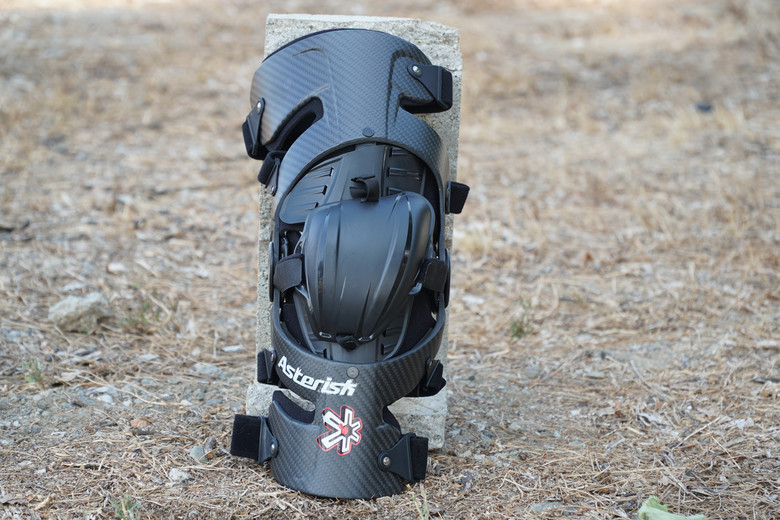 Asterisk Carbon Cell knee brace carbon fiber frame detail and slim profile.
Asterisk Carbon Cell knee brace carbon fiber frame detail and slim profile.
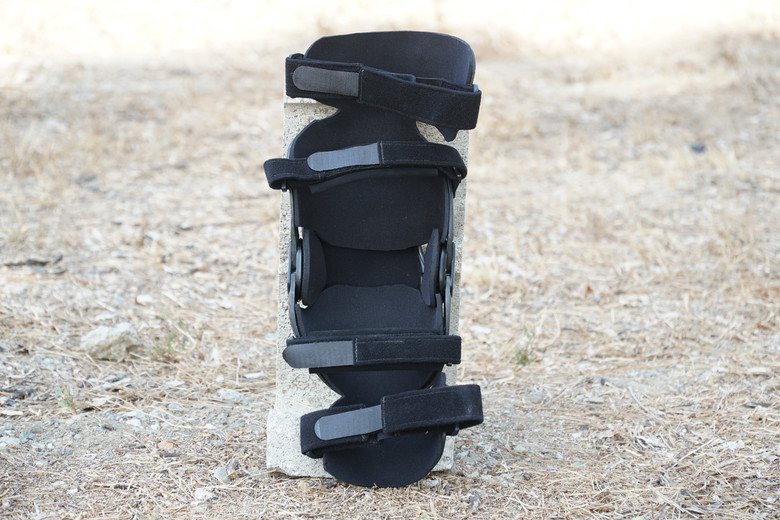 Asterisk Carbon Cell knee brace strap system and rigid carbon cuffs.
Asterisk Carbon Cell knee brace strap system and rigid carbon cuffs.
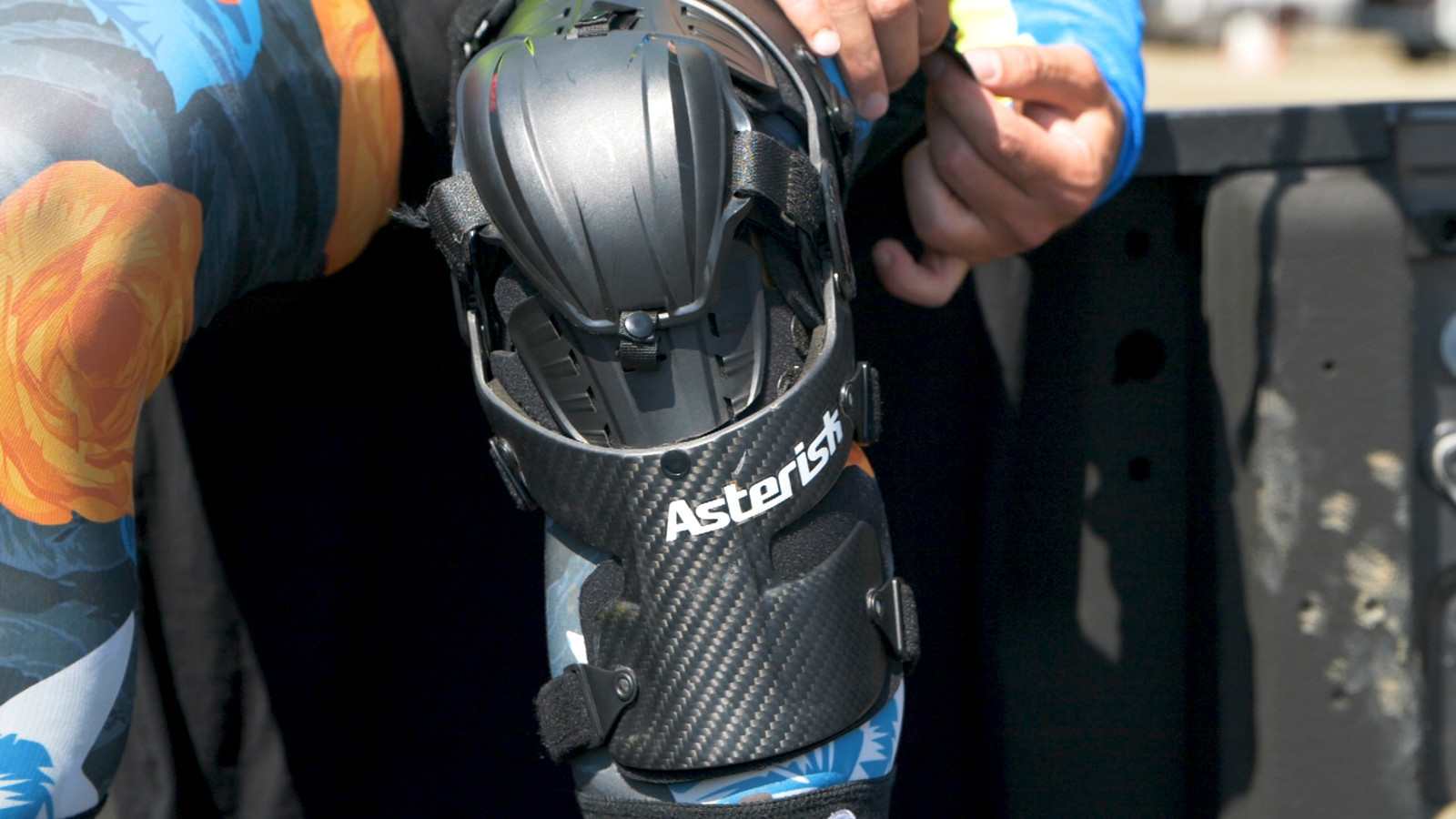 Rider wearing Asterisk Carbon Cell knee brace, highlighting low profile under riding pants.
Rider wearing Asterisk Carbon Cell knee brace, highlighting low profile under riding pants.
Asterisk, a long-standing name in motocross knee protection, brings decades of experience to the Carbon Cell brace. This model is designed for a super-thin, custom-like feel, emphasizing a sleek profile and premium materials.
Tester Notes:
What We Liked:
The Asterisk Carbon Cell brace is immediately striking for its exceptional carbon fiber frame. Testers lauded the frame’s aesthetics, comparing it to high-end components found on factory race bikes and exotic vehicles. The meticulous detailing and flawless finish contribute to a premium feel.
Bike feel was a major highlight. The brace provided a broad and even pressure distribution when gripping the bike, and the 13mm hinge thickness felt neutral and unobtrusive. The pivoting hinge, similar to the CTi, features a sweeping motion that allows the lower frame to move slightly under the upper frame, resulting in a more natural knee movement.
The Carbon Cell is the slimmest knee brace in the test, a significant advantage for riders using modern slim-fit riding pants. The low-profile frame, minimalist strap system, and average hinge thickness allow the brace to virtually disappear under riding gear, offering maximum mobility, especially beneficial for riders with larger legs.
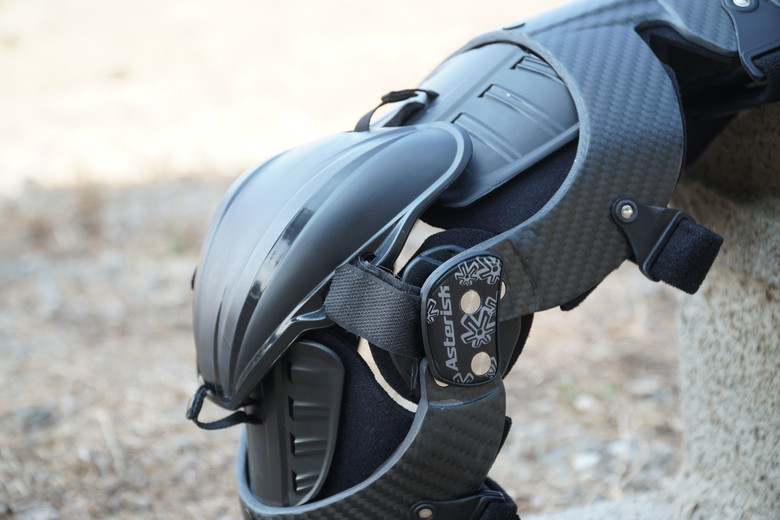 Asterisk Carbon Cell patella cup coverage and sliding fixed guards, showcasing protection features.
Asterisk Carbon Cell patella cup coverage and sliding fixed guards, showcasing protection features.
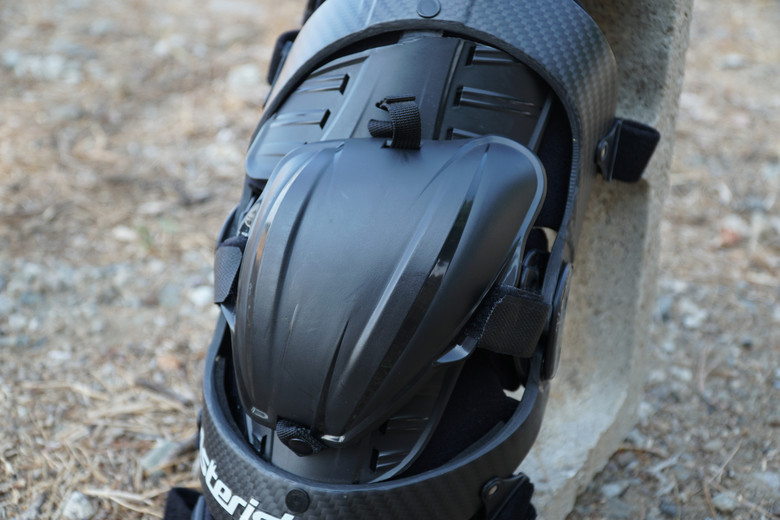 Asterisk Carbon Cell patella cup strap and padding wear concerns.
Asterisk Carbon Cell patella cup strap and padding wear concerns.
 Close-up of Asterisk Carbon Cell carbon frame weave and construction.
Close-up of Asterisk Carbon Cell carbon frame weave and construction.
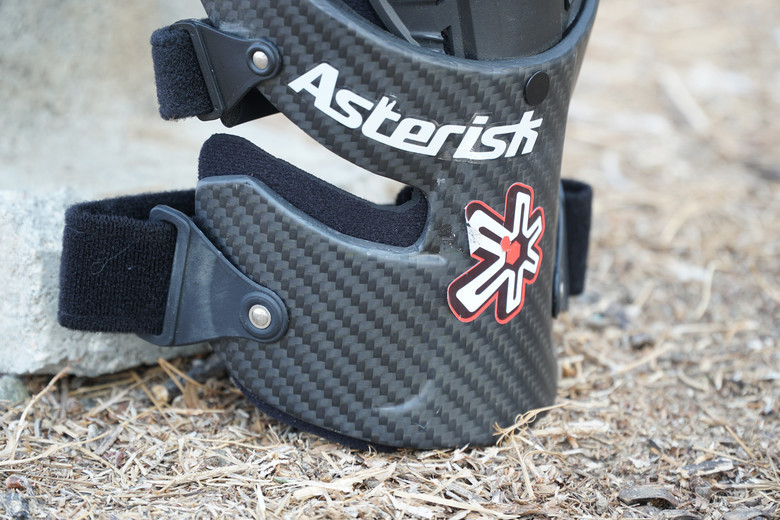 Asterisk Carbon Cell low profile frame conforming to the leg.
Asterisk Carbon Cell low profile frame conforming to the leg.
What We Didn’t Like:
Despite the frame’s high-quality design, the foam padding appeared to be less refined. The foam’s cut and material quality seemed rudimentary compared to other braces, appearing to be cut from neoprene sheets and attached with Velcro. Testers noted some areas with scissor-cut finishes, detracting from the overall premium feel.
The patella cup design and attachment method seemed dated, reminiscent of older brace models. Unlike modern designs that use elastic bands for self-centering, the Carbon Cell’s patella cup is held by Velcro and buttoned straps, resulting in a less secure, floating feel.
Durability concerns arose after initial rides. Black dust was observed, originating from plastic plates rubbing against the patella cup padding. The inner Velcro straps securing the patella cup showed wear after minimal use. Padding on the hinges, attached with small adhesive Velcro strips, began to detach quickly. While fixable, these wear and tear issues were unexpected at this price point.
 Asterisk Carbon Cell padding appearing rudimentary and potentially an afterthought.
Asterisk Carbon Cell padding appearing rudimentary and potentially an afterthought.
 Thin neoprene padding of Asterisk Carbon Cell, considered disappointing by testers.
Thin neoprene padding of Asterisk Carbon Cell, considered disappointing by testers.
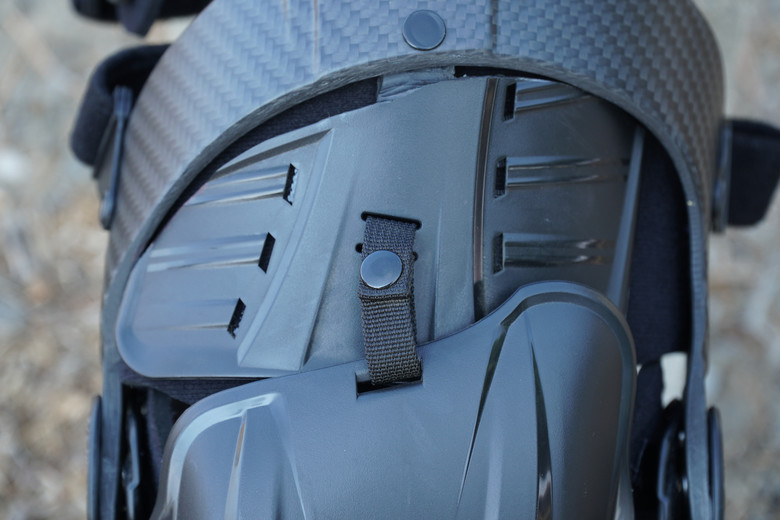 Asterisk Carbon Cell patella cup floating and less securely positioned compared to other braces.
Asterisk Carbon Cell patella cup floating and less securely positioned compared to other braces.
Overall Impression:
The Asterisk Carbon Cell excels in its slim profile and exceptional bike feel, largely due to its beautifully crafted carbon fiber frame. However, the rudimentary padding, dated patella cup design, and early wear and tear issues detract from its overall value proposition. While offering excellent mobility and a sleek feel, durability and padding refinement are areas for potential improvement.
POD K8 Knee Brace Review
PRICE: $799.95
HINGE THICKNESS: 15.2 mm
WEIGHT: 3.1 lb pair, size XL
FRAME PROFILE THICKNESS 1-10: 6
STRAP STYLE: 4 individual straps
STRAP MEMORY: Yes (top thigh and lower calf)
CUFF CLOSURE: Firm but pliable plastic
HINGE STYLE: Artificial Ligament Hinge
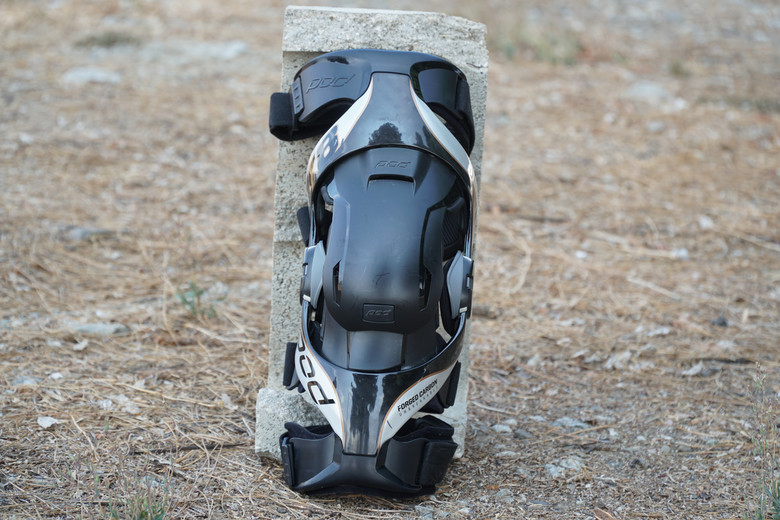 POD K8 knee brace artificial ligament hinge and carbon fiber frame.
POD K8 knee brace artificial ligament hinge and carbon fiber frame.
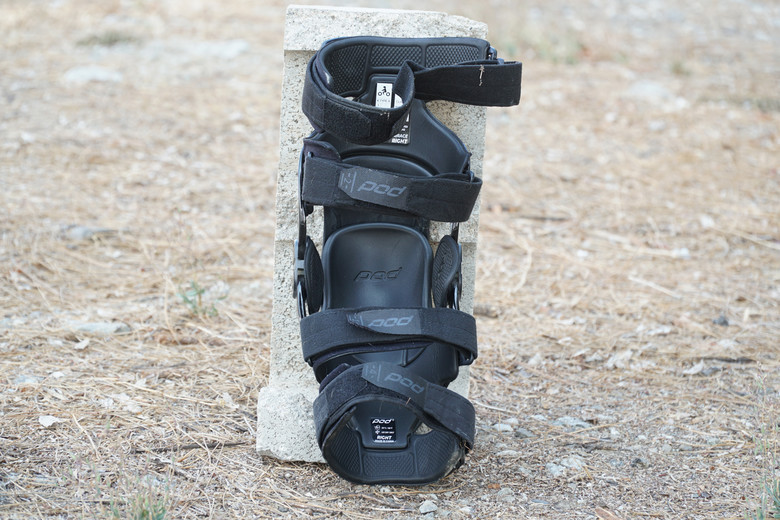 POD K8 knee brace strap memory clips and semi-flexible cuffs.
POD K8 knee brace strap memory clips and semi-flexible cuffs.
 Rider wearing POD K8 knee brace, showcasing fit and profile on the leg.
Rider wearing POD K8 knee brace, showcasing fit and profile on the leg.
The POD K8 stands out with its unique artificial ligament hinge, mimicking the human knee joint’s function using a steel cable for enhanced strength. This design aims to provide a natural and fluid knee motion with robust protection.
Tester Notes:
What We Liked:
Initial fitting of the POD K8 was comfortable, with semi-flexible calf and thigh closures that conformed well to the leg, complemented by adequate internal padding. The brace’s flexion felt remarkably natural and effortless, a hallmark of POD’s ligament hinge design. By emulating the knee’s ligament structure (ACL, MCL, PCL, LCL), the K8’s artificial ligament offers a logical and biomechanically sound approach to knee protection.
A standout feature is the “Memory” strap system on the upper and lower straps, utilizing clips that snap into the frame. This allows riders to set the strap size once, enabling quick and consistent brace application and removal, a time-saving convenience.
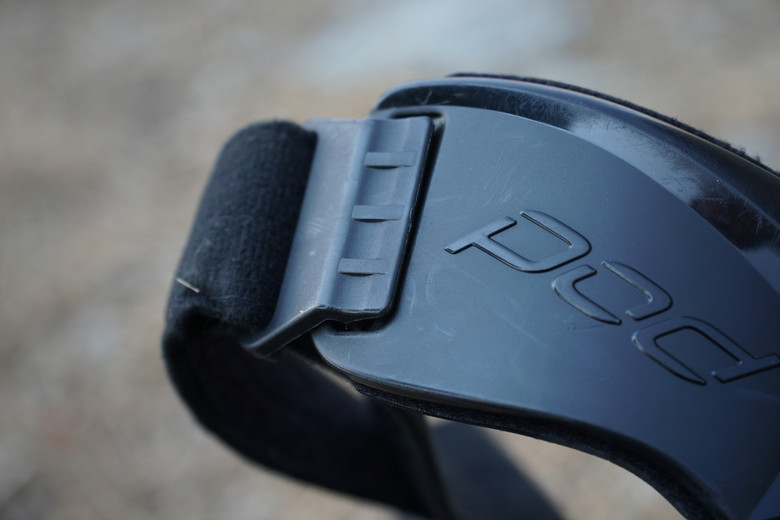 POD K8 strap memory clips on top and bottom straps for quick application.
POD K8 strap memory clips on top and bottom straps for quick application.
 Close-up of POD K8 synthetic ligament hinge, highlighting unique design.
Close-up of POD K8 synthetic ligament hinge, highlighting unique design.
 POD K8 top and bottom cuffs made of firm but slightly flexible plastic.
POD K8 top and bottom cuffs made of firm but slightly flexible plastic.
What We Didn’t Like:
The patella protection, while smooth and unobtrusive during riding, proved awkward when kneeling in the pits for bike maintenance. At full knee bend, the frames pinched the thighs slightly above the hinge, a common issue with knee braces attempting to balance slimness with muscle flexion accommodation.
The POD K8, along with the EVS Axis Pro, exhibited distinct contact points against the bike. While providing a positive and direct feel for bike grip, this could lead to knee soreness after extended riding sessions for some riders.
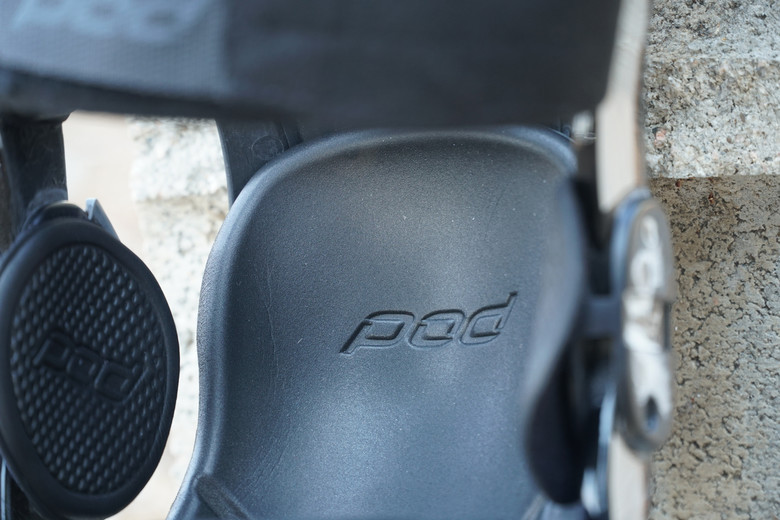 POD K8 padding thickness and comfort level.
POD K8 padding thickness and comfort level.
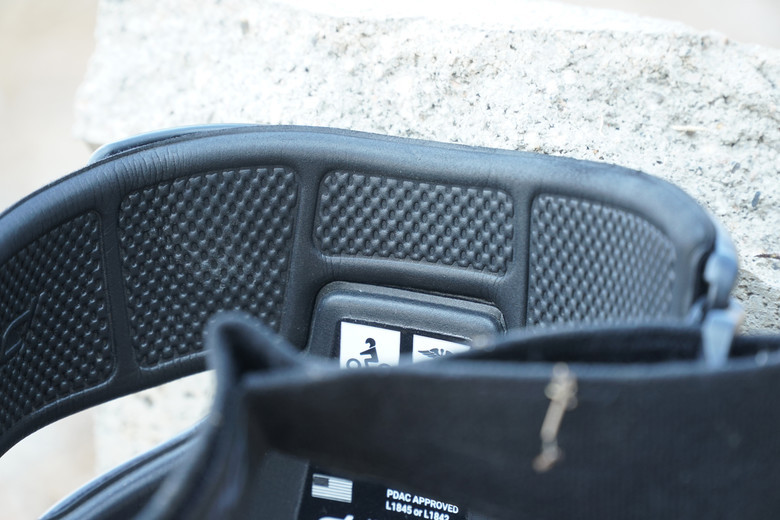 POD K8 padding grip texture and performance.
POD K8 padding grip texture and performance.
 POD K8 two-piece patella cup design, showing articulation and potential kneeling discomfort.
POD K8 two-piece patella cup design, showing articulation and potential kneeling discomfort.
 POD K8 carbon frame lightweight and rigid construction.
POD K8 carbon frame lightweight and rigid construction.
Overall Impression:
The POD K8 is a lightweight and comfortable brace with a unique and effective hinge design that promotes natural knee movement. Its memory straps are a practical convenience. Minor drawbacks include patella cup awkwardness when kneeling, thigh pinching at full bend, and potential pressure points against the bike for some riders. However, its lightweight feel, comfortable fit (once sized correctly), and innovative hinge make it a top consideration for riders seeking minimal bulk and maximum mobility with reliable protection.
EVS Axis Pro Knee Brace Review
PRICE: $749.95
HINGE THICKNESS: 14.9 mm
WEIGHT: 4.36 lb pair, size XL
FRAME PROFILE THICKNESS 1-10: 7
STRAP STYLE: 5 individual straps
STRAP MEMORY: No
CUFF CLOSURE: Rigid Carbon Fiber
HINGE STYLE: Mechanical
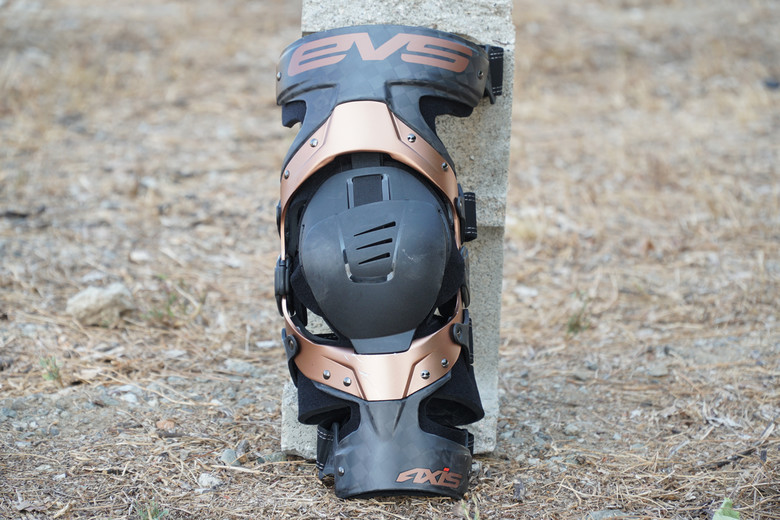 EVS Axis Pro knee brace carbon fiber and aluminum frame construction.
EVS Axis Pro knee brace carbon fiber and aluminum frame construction.
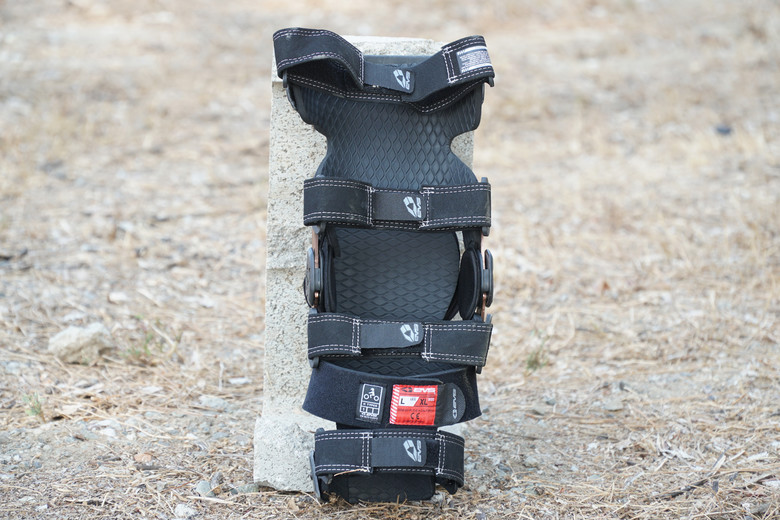 EVS Axis Pro knee brace strap system and material combination.
EVS Axis Pro knee brace strap system and material combination.
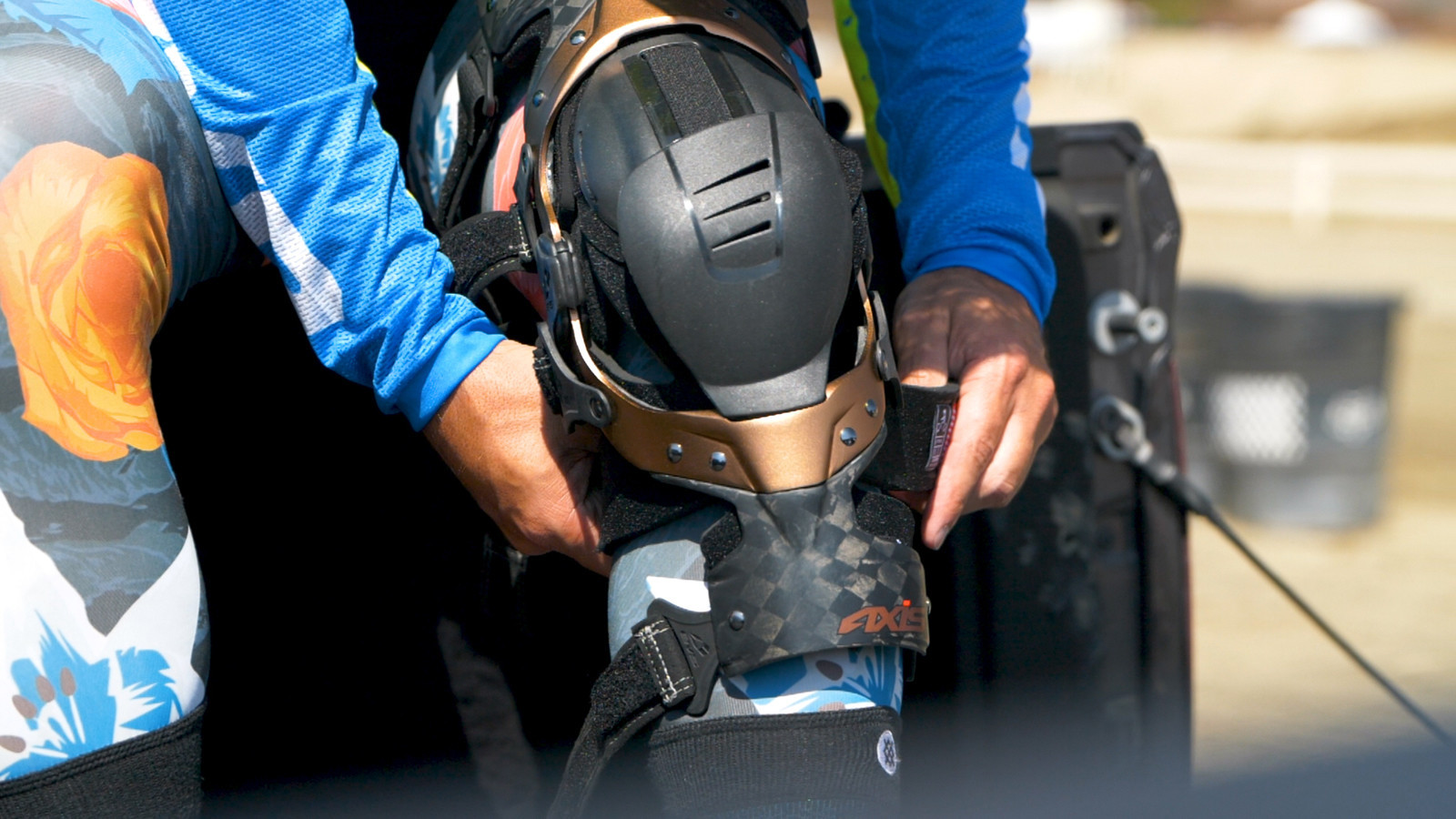 Rider wearing EVS Axis Pro knee brace, showcasing coverage and bulk.
Rider wearing EVS Axis Pro knee brace, showcasing coverage and bulk.
 EVS Axis Pro two-piece patella cup design and comfort features.
EVS Axis Pro two-piece patella cup design and comfort features.
The EVS Axis Pro distinguishes itself with a visually appealing and robust frame, combining a large weave carbon fiber thigh and calf cuff with a bronze anodized aluminum cage. The seamless integration of these materials enhances both aesthetics and structural integrity.
Tester Notes:
What We Liked:
The Axis Pro’s construction quality translated directly to a secure and substantial feel on the leg. The brace’s size and material combination provided a high level of perceived security and knee protection. Generous internal padding contributed to a comfortable and conforming fit, allowing the brace to adapt to the knee and thigh contours.
Frontal protection is comprehensive, with no gaps from top to bottom, ensuring consistent coverage whether the leg is bent or straight. The elastic band maintaining patella cup proximity to the knee and gliding action over the upper and lower sections was a well-received feature. EVS’s use of a large foam piece extending from the shin to the kneecap facilitates smooth patella plate movement without direct knee contact.
Pivoting strap rings, used extensively for both inner and outer strap connections, allow for precise strap adjustment and a snug fit to the leg’s anatomy.
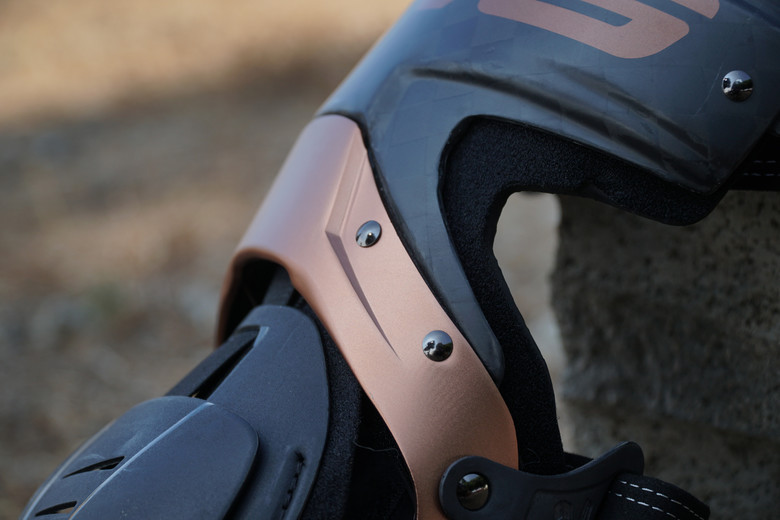 EVS Axis Pro build quality and material junctions.
EVS Axis Pro build quality and material junctions.
 EVS Axis Pro carbon and aluminum frame stiffness and heavier weight.
EVS Axis Pro carbon and aluminum frame stiffness and heavier weight.
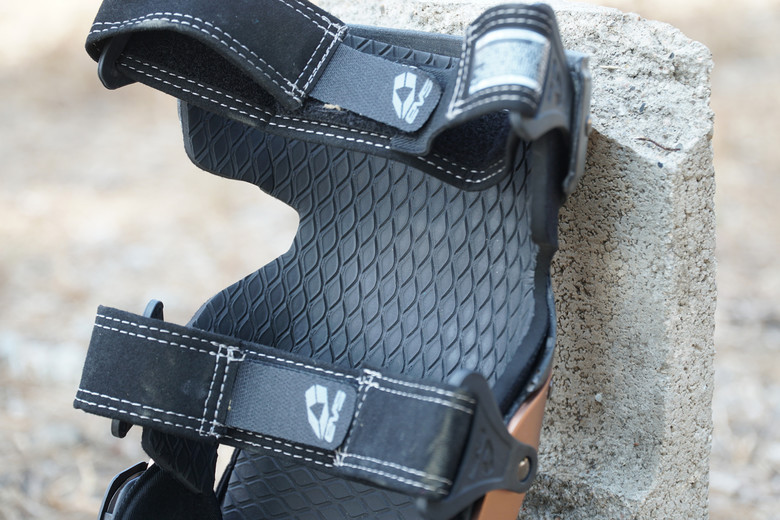 EVS Axis Pro padding grip and wide, robust strap design.
EVS Axis Pro padding grip and wide, robust strap design.
What We Didn’t Like:
Similar to the POD K8, the Axis Pro exhibited distinct contact points against the bike, which, while providing a positive bike feel, could become tiring or uncomfortable during longer rides. The purpose of a “5th” calf strap remained unclear to testers. Its thickness and doubling-over design added bulk without a clear functional benefit.
The lower frame section around the shin had an unusual, wide “U” shape, potentially causing pressure points on the shin bone due to uneven pressure distribution. This shape also created bulk and gaps around the shin, requiring boot buckle adjustments to accommodate the brace.
 EVS Axis Pro fifth strap placement and unclear function.
EVS Axis Pro fifth strap placement and unclear function.
 EVS Axis Pro lower cuff shape and potential shin discomfort.
EVS Axis Pro lower cuff shape and potential shin discomfort.
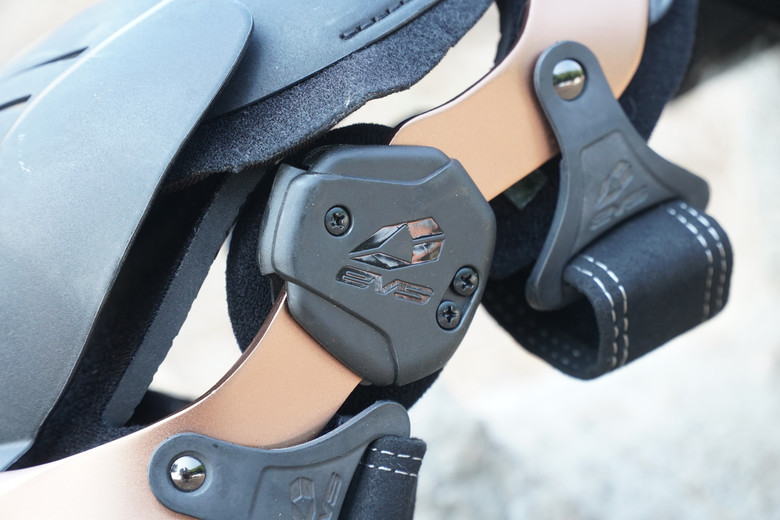 EVS Axis Pro hinge pressure point feel, similar to POD K8.
EVS Axis Pro hinge pressure point feel, similar to POD K8.
Overall Impression:
The EVS Axis Pro is a well-constructed and visually impressive brace that prioritizes robust protection and a secure feel. Its high-quality materials and comprehensive coverage inspire confidence. However, its heavier weight, bulkier profile, potential pressure points, and the ambiguous “5th” strap are minor drawbacks. Riders seeking maximum protection and a substantial brace feel may find the Axis Pro appealing, while those prioritizing lightweight and minimal bulk might consider other options.
Mobius X8 Knee Brace Review
PRICE: $599.95
HINGE THICKNESS: 13.1 mm
WEIGHT: 3.65 lb pair, size XL
FRAME PROFILE THICKNESS 1-10: 7
STRAP STYLE: 3 Individual Straps and 1 cable routed strap
STRAP MEMORY: No
CUFF CLOSURE: Semi-flexible glass filled nylon
HINGE STYLE: Pivoting hinge
 Mobius X8 knee brace full coverage frame and unique strap system.
Mobius X8 knee brace full coverage frame and unique strap system.
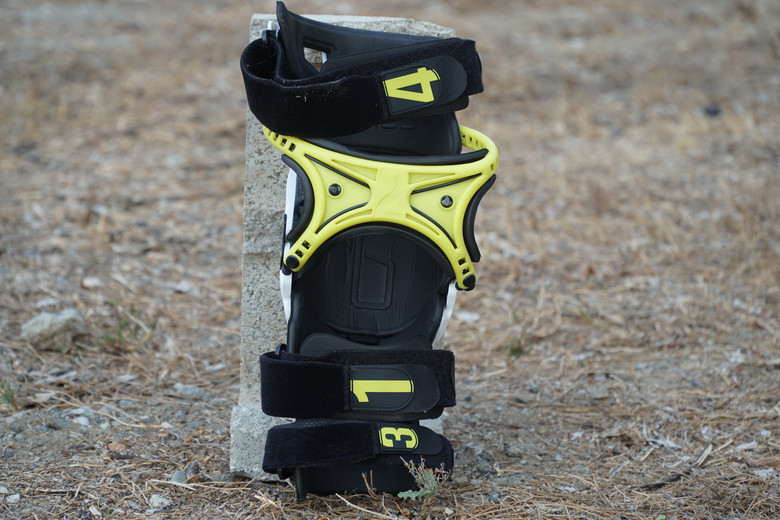 Mobius X8 knee brace ratchet cable system and glass-filled nylon frame.
Mobius X8 knee brace ratchet cable system and glass-filled nylon frame.
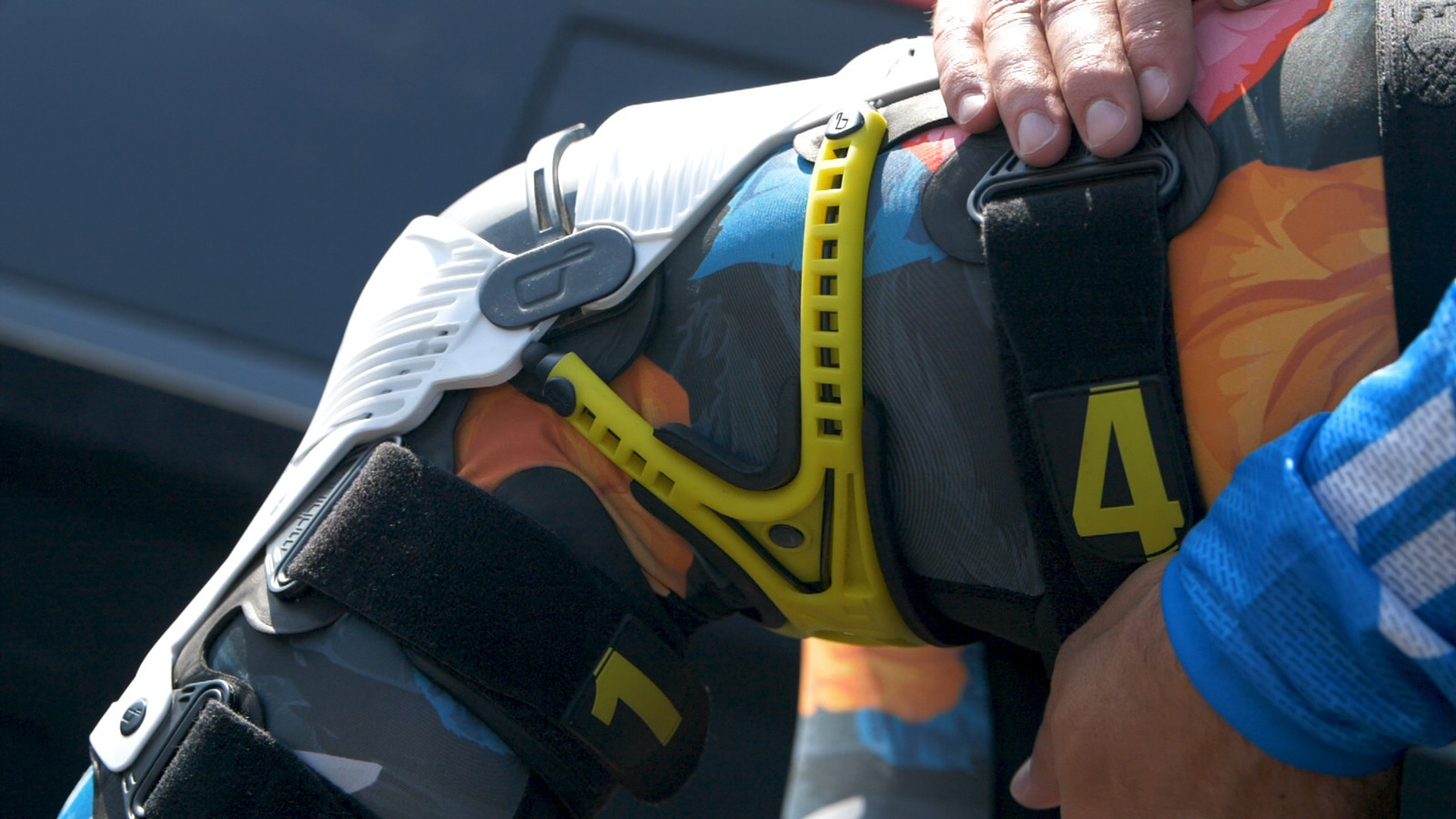 Rider wearing Mobius X8 knee brace, showcasing unique design and profile.
Rider wearing Mobius X8 knee brace, showcasing unique design and profile.
The Mobius X8 stands out with several unique features, including a full coverage frame, hidden patella cup, flush hinges, and a distinctive ratcheting cable strap system, representing a significant departure from traditional knee brace designs.
Tester Notes:
What We Liked:
Comfort was a primary strength of the Mobius X8, attributed largely to the glass-filled nylon frame material. This material makes the brace the least rigid in the test, offering flex in multiple directions. While frame rigidity is crucial for knee stabilization, the nylon’s flexibility allows the brace to adapt to individual leg shapes, enhancing comfort. The solid frame design provides a secure, “hugging” sensation when fastened.
The straps and Velcro were highly praised. Significantly wider than other braces, the straps provide a secure and comfortable hold without digging into the leg. The Velcro is exceptionally strong, ensuring straps remain firmly in place, even under demanding riding conditions.
Bike contact feel was excellent, similar to the Asterisk Carbon Cell, with broad and even pressure distribution. The seamless transition between frame and hinge allows for unrestricted bike squeezing without pressure points or plastic contours. The flat hinge surface eliminates the stepped feeling sometimes encountered with traditional hinge designs, allowing for smooth movement against the bike and gear.
The hidden patella cup, positioned behind the frame when the leg is straight, creates an ultra-sleek exterior, minimizing snagging on pant liners.
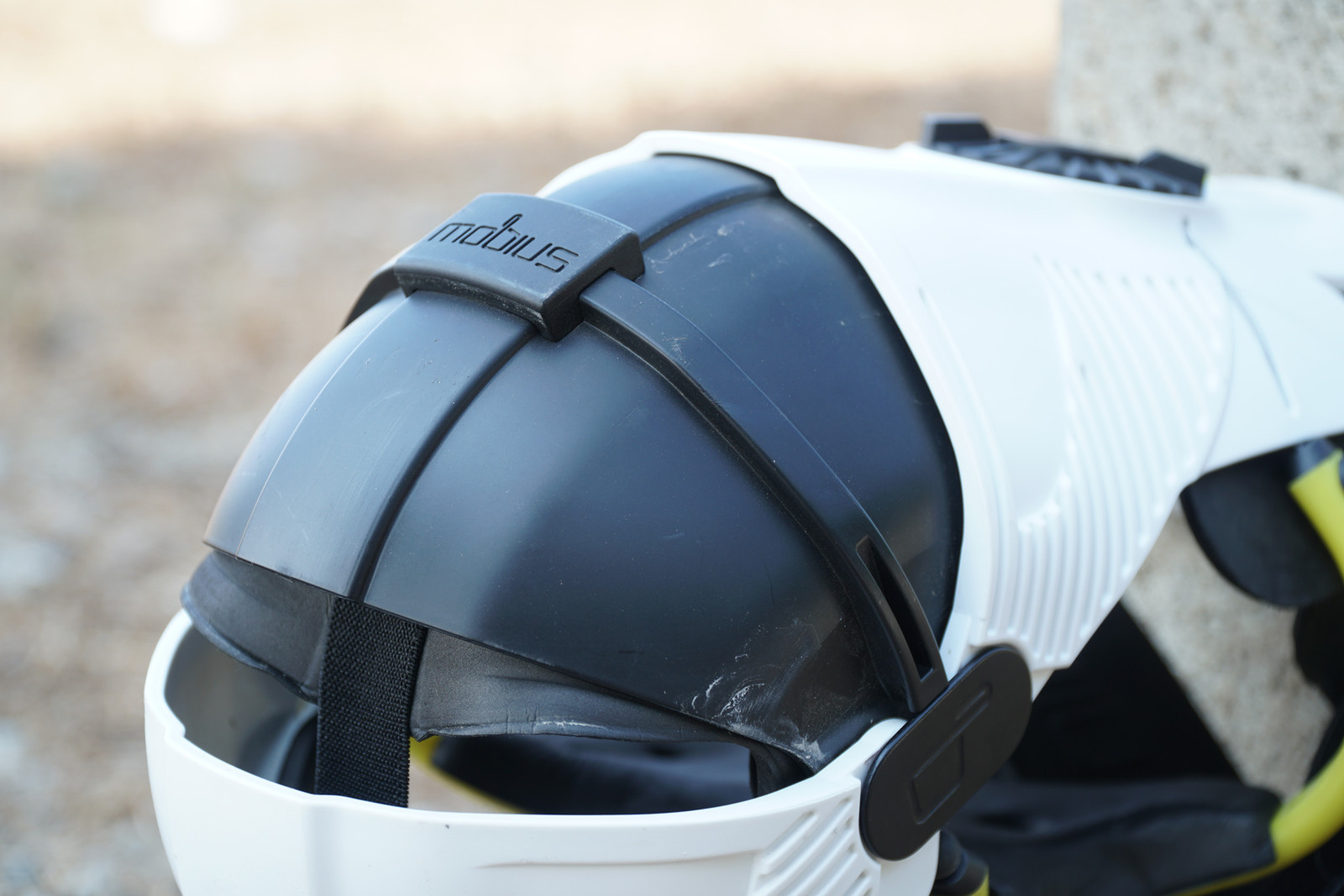 Mobius X8 hidden patella cup design and sleek exterior profile.
Mobius X8 hidden patella cup design and sleek exterior profile.
 Mobius X8 ratchet system bulk and perceived necessity.
Mobius X8 ratchet system bulk and perceived necessity.
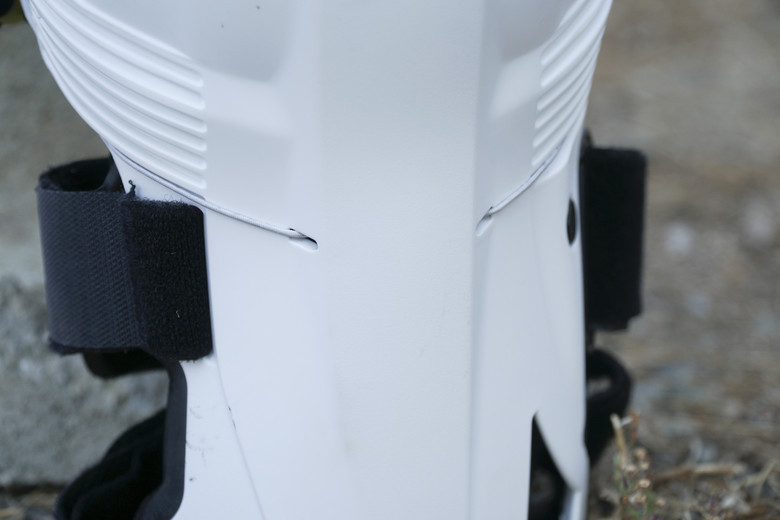 Mobius X8 steel cable routing behind the brace to the shin plate.
Mobius X8 steel cable routing behind the brace to the shin plate.
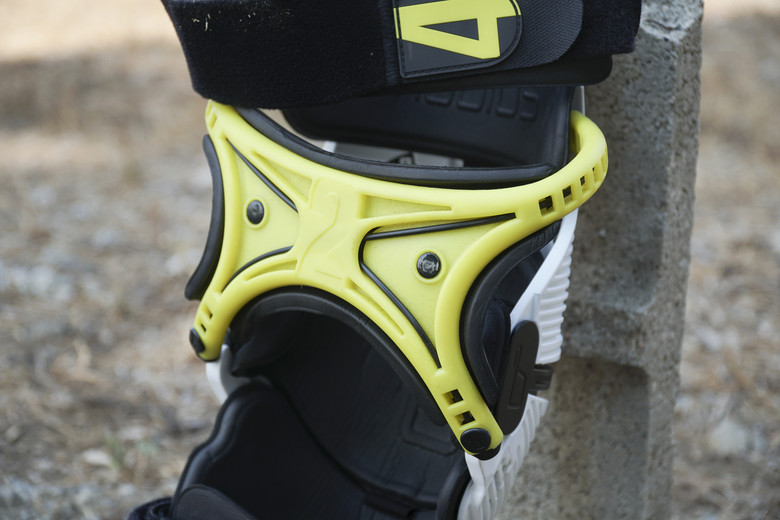 Mobius X8 x-strap always attached, requiring step-through entry.
Mobius X8 x-strap always attached, requiring step-through entry.
What We Didn’t Like:
The upper brace section felt bulky, primarily due to the ratcheting closure and the “X” cable strap on the lower thigh. This added bulk could make fitting slim riding pants challenging.
While comfortable, the Mobius X8 felt less secure in the shin area compared to the Asterisk Carbon Cell when worn side-by-side. A noticeable gap below the patella cup contributed to this less secure feeling, although less apparent when worn alone.
Heat retention became an issue in hotter weather. The solid frame design, while comfortable and protective, limited airflow, making the Mobius X8 warmer than other braces in temperatures above 90 degrees Fahrenheit.
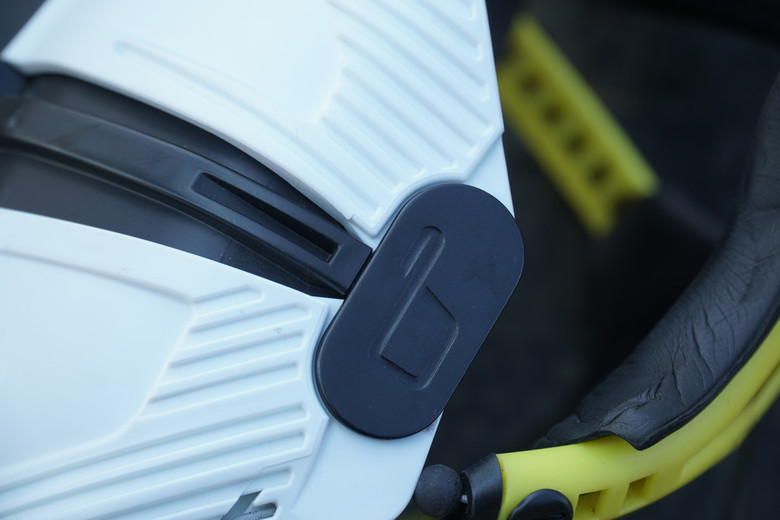 Mobius X8 hinge flush design and minimal profile.
Mobius X8 hinge flush design and minimal profile.
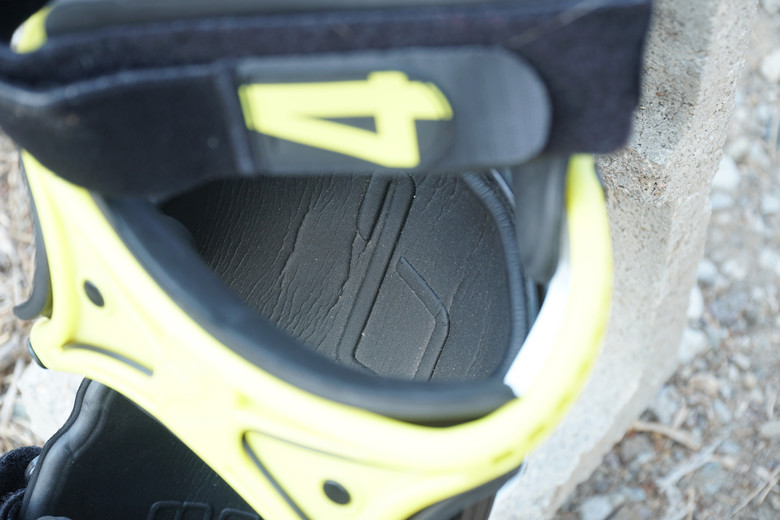 Mobius X8 ample padding throughout the brace, contributing to comfort and bulk.
Mobius X8 ample padding throughout the brace, contributing to comfort and bulk.
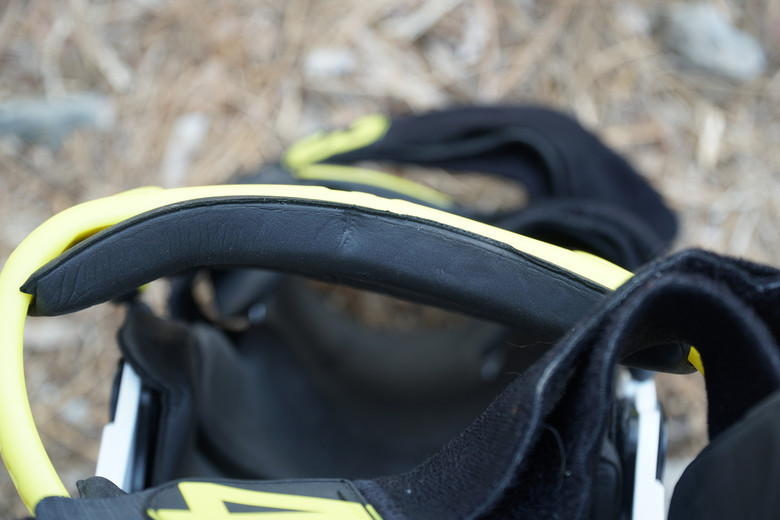 Mobius X8 x-strap padding thickness and bulk behind the leg.
Mobius X8 x-strap padding thickness and bulk behind the leg.
Overall Impression:
The Mobius X8 excels in comfort and bike feel, with a unique and innovative design. Its flexible frame, comfortable padding, and excellent strap system are major strengths. However, its bulkier upper section, potential shin security concerns (compared to more rigid braces), and heat retention in hot weather are drawbacks. Riders prioritizing comfort and a less restrictive feel with good bike contact, and who don’t frequently ride in extreme heat, may find the Mobius X8 a strong contender. Those seeking maximum rigidity and a slimmer profile might explore other options.
Leatt X-Frame Knee Brace Review
PRICE: $469.99
HINGE THICKNESS: 11 mm
WEIGHT: 3.45 lb pair, size XXL
FRAME PROFILE THICKNESS 1-10: 5
STRAP STYLE: 4 Individual Straps
STRAP MEMORY: No
CUFF CLOSURE: Carbon Composite frame
HINGE STYLE: Mechanical Hinge
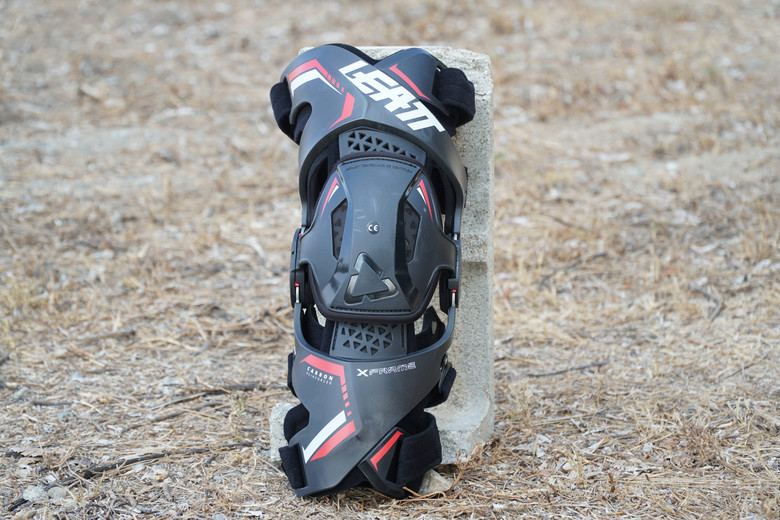 Leatt X-Frame knee brace carbon composite frame and thin hinge.
Leatt X-Frame knee brace carbon composite frame and thin hinge.
 Leatt X-Frame knee brace floating patella cup and strap details.
Leatt X-Frame knee brace floating patella cup and strap details.
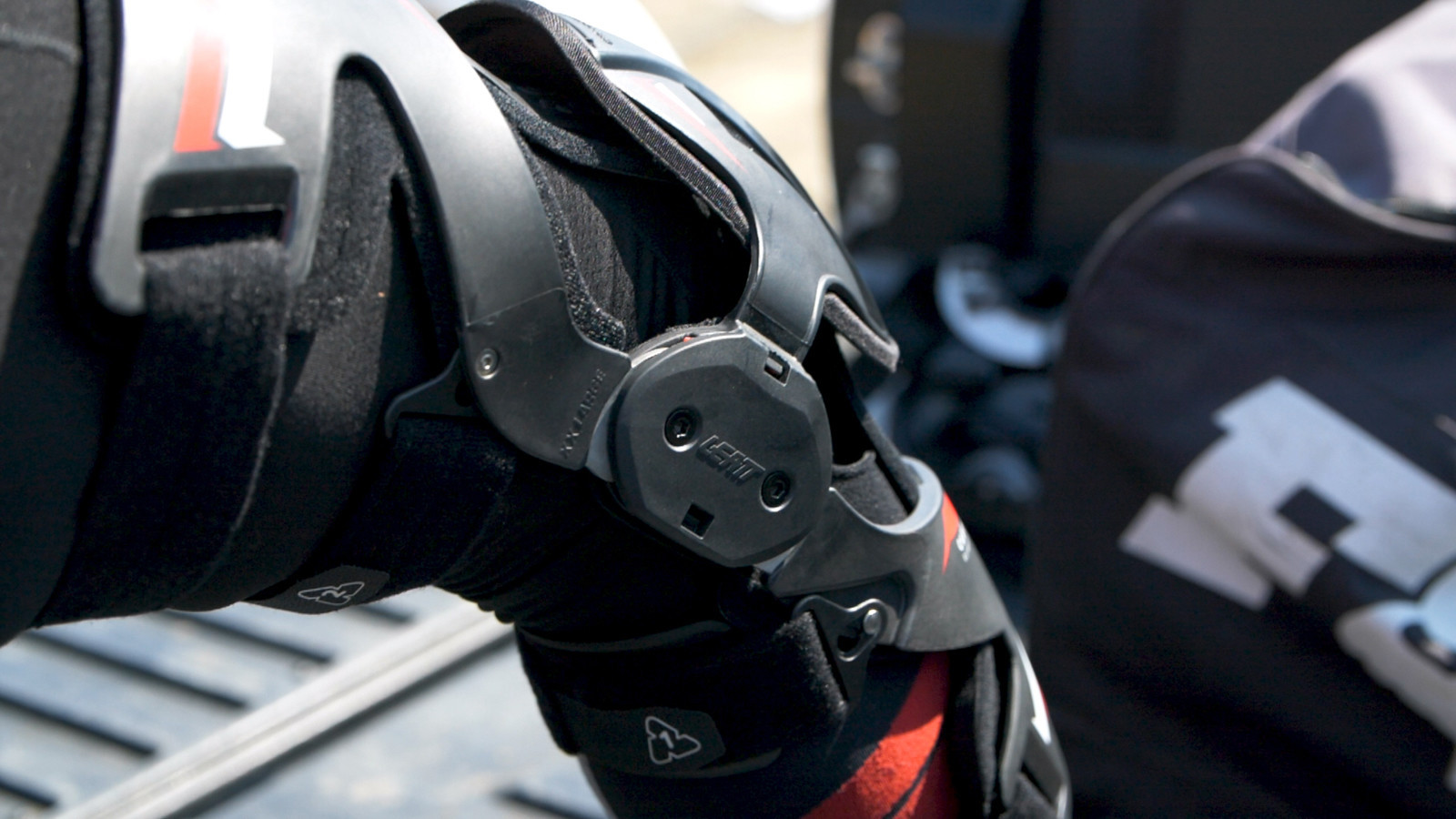 Rider wearing Leatt X-Frame knee brace, showcasing slim fit and profile.
Rider wearing Leatt X-Frame knee brace, showcasing slim fit and profile.
Leatt, known for its pioneering role in neck brace technology, extends its protective gear expertise to knee braces. The X-Frame is Leatt’s mid-range offering, featuring a more traditional frame shape compared to their single-sided C-Frame model.
Tester Notes:
What We Liked:
Bike feel was a standout feature of the Leatt X-Frame, ranking among the best in the test. The hinge, the thinnest in the group, combined with the flat inner frame surface, provided exceptionally broad pressure distribution when gripping the bike. Testers described feeling bike contact from the calf all the way up to the thigh, enhancing control and connection.
The carbon composite frame incorporates flexible plastic tabs on the upper and lower calf closures, allowing for slight flex and adaptation to leg contours. Airflow was also a positive aspect, with perforated panels and foam promoting ventilation and reducing heat buildup.
 Leatt X-Frame floating rigid patella cup design.
Leatt X-Frame floating rigid patella cup design.
 Leatt X-Frame patella cup protrusion when knee is bent, affecting pant fit.
Leatt X-Frame patella cup protrusion when knee is bent, affecting pant fit.
What We Didn’t Like:
The patella cup design was the most significant drawback. Its protruding design when the knee is bent caused noticeable pant tightness and pulling, particularly with snug-fitting race pants. Looser pants were necessary for comfortable use.
The lower frame section below the patella cup comes to a point, which, while potentially aesthetic or functional, added bulk in the shin area. This point interfered with boot shin plate closures, requiring boot buckle loosening.
Durability concerns arose during testing. After approximately 7-8 hours of use, the right brace developed a noticeable “click” in the hinge, especially when transitioning from sitting to standing. Despite cleaning and reassembling the hinge, the clicking persisted, raising concerns about long-term hinge integrity.
 Leatt X-Frame hinge thin profile and mechanical design.
Leatt X-Frame hinge thin profile and mechanical design.
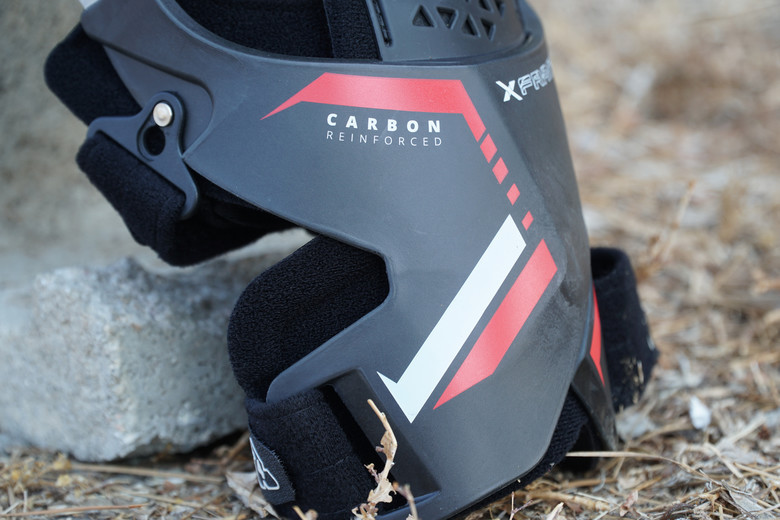 Leatt X-Frame slim fit profile compared to other braces.
Leatt X-Frame slim fit profile compared to other braces.
Overall Impression:
The Leatt X-Frame offers excellent bike feel and good airflow, with a slim fit profile. However, the protruding patella cup design, lower frame point interference with boots, and hinge durability concerns are significant drawbacks. While offering a more affordable price point compared to other carbon braces, riders should carefully consider these limitations, particularly regarding patella cup interference with riding pants and potential hinge clicking issues.
Final Thoughts: Choosing the Right Dirt Bike Knee Brace
Selecting the ideal dirt bike knee brace is a personal decision. Despite extensive testing and detailed analysis, a single “best” brace doesn’t exist. Individual rider priorities, preferences, and riding styles will heavily influence the optimal choice.
Ultimately, personal preferences emerged: One tester favored the Mobius X8 for comfort and bike feel, and the Asterisk Carbon Cell for its slim fit and functionality. The other tester preferred the POD K8 for its lightweight feel and minimal bulk, and the CTi OTS for its exceptional comfort and robust protection.
When considering dirt bike knee braces, weigh your individual needs, prioritize features that align with your riding style and comfort requirements, and carefully review the pros and cons of each model. This detailed comparison aims to provide the necessary information for you to make a well-informed decision and invest in the knee protection that best suits your needs.

